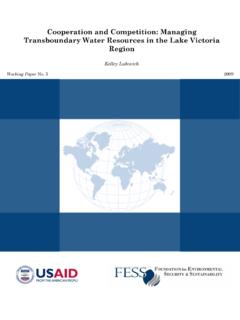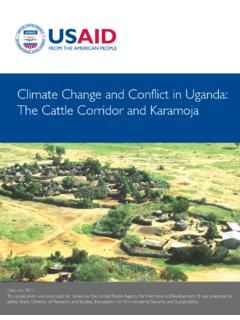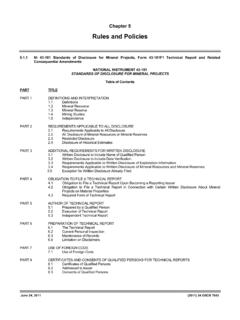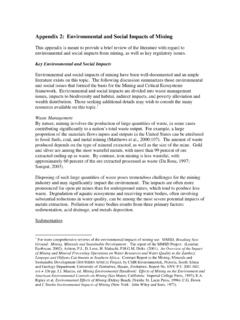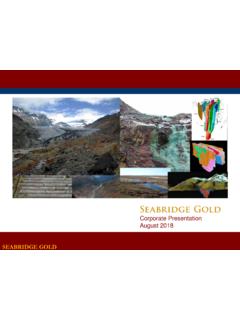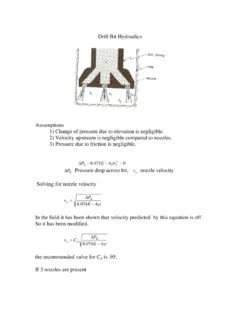Transcription of Environmental Safeguards and Community Benefits in …
1 Environmental Safeguards and Community Benefits in mining : Recent Lessons from the Philippines Jeffrey Stark, Jennifer Li, and Katsuaki Terasawa 2006 Working Paper No. 1 Working Paper Source: Working Paper 1 Introduction In October 2005, the Foundation for Environmental Security and Sustainability (FESS) and the Croft Institute for International Studies at The University of Mississippi launched an Environmental security assessment of the Philippines. FESS has developed the Environmental Security Assessment Framework (ESAF) as the methodology used for such assessments.
2 The framework is structured to identify risks to nations and regions that arise as a result of the confluence of Environmental and political, economic, and societal factors, and to evaluate the implications of these risks. The goal of the ESAF is to inform policymakers, facilitate the establishment of priorities, and contribute to the development of effective and sustainable policies in the public and private sectors. The concept of Environmental security is relatively new, and there are a number of competing definitions and varying interpretations of the term.
3 In its work, FESS employs the following working definition: Environmental security is a condition in which a nation or region, through sound governance, capable management, and sustainable utilization of its natural resources and environment, takes effective steps toward creating social, economic, and political stability and ensuring the welfare of its population. In the fall of 2005, the FESS-Croft research team met with nearly 80 government officials, elected representatives, civil servants, military personnel, policy experts, academics, civil society professionals, and private sector representatives in Manila and several different provinces, including Benguet, Capiz, Davao del Sur, Misamis Oriental, Negros Oriental, and Palawan.
4 Based on this first round of meetings, the research team decided that the study would focus on mining as the most significant sector for the future of Environmental security in the Philippines. The emphasis on mining resulted from several findings from the first round of interviews: In the context of the troubled history of mining in the Philippines, the fast-track approach reflected in the push by President Gloria Arroyo and the Department of the Environment and Natural Resources (DENR) to encourage a rapid increase in large-scale mining investments alarmed many communities and appeared likely to generate conflict.
5 The credibility of and trust for mining companies and the relevant government agencies was extremely low in all regions visited. In fact, in private interviews local officials were even more skeptical of statements by firms and the DENR than in public. The DENR was seen as ineffective and subject to capture by powerful political and economic interests. Although leaders of the highly influential Catholic Church expressed a variety of positions regarding the extraction of natural resources, Church leaders in localities with mining operations were often active opponents of extractive industry initiatives.
6 The rapid opening of the mining sector to large-scale foreign investment seemed to portend a possible paradox: Quick-hit investments might lead in the medium term to negative Environmental and social consequences, Community -based protests and conflict, and a net reduction of foreign direct investment. Working Paper 2 In February 2006, the FESS-Croft team returned to visit mine sites and/or conduct interviews in Albay, Benguet, Manila, Palawan, Sorsogon, Surigao del Norte, and Zamboanga del Norte. In meetings with government officials, company representatives, NGO staff, and Catholic clergy, a number of basic questions were explored: Is the opening of the mining sector to foreign investment likely to improve significantly the financial profile and debt situation of the Philippines?
7 What is the potential of the mining sector to alleviate poverty, provide employment, and enhance the social welfare of communities? What are the associated Environmental and social risks? How is the opening of the mining sector likely to affect the interests of indigenous groups? Will mining significantly increase revenues available to local communities? Will mining lead to significant positive economic spin-off effects, such as downstream economic activities and diversification of the economy? How can communities be better incorporated in decision making involving mining issues?
8 What practical actions can be taken by both public and private actors to avoid or mitigate any negative effects of mining on social peace, Environmental conditions, and the economic well-being of mining communities and surrounding areas? How can the rhetoric of responsible mining be turned into a reality that engenders the confidence and trust of mining communities and surrounding areas? The Troubled Legacy of mining in the Philippines Background Many of the 7,000-plus islands of the Philippine archipelago sit on underwater volcanic mountains formed by molten rocks from the earth s center.
9 The molten rocks are rich in minerals, and have left large mineral deposits scattered throughout the country (Lyday 2002). In terms of metallic minerals, these include: 1) precious metals (gold, silver, platinum); 2) base metals (copper, lead, zinc, mercury, cadmium); 3) iron alloys (chromite and nickel); 4) light metals (bauxite and manganese); 5) iron; and 6) rare metals (uranium) (Mines and Geosciences Bureau ). In terms of estimated value, the country is richest in nickel (Ni), gold (Au), copper (Cu), and chromite (Cr).
10 Based on density of deposits per one-square-kilometer land area, the country is ranked third in the world in gold deposits, fourth in copper reserves, fifth in nickel, and sixth in chromite (Business World 2005). The large-scale production of the chief metallic minerals in the Philippines has experienced fluctuations of varying magnitudes in recent decades. There was a boom from 1982-1988, a slow decline from 1988-1997, followed by a moderately erratic pattern from 1997-2000. In 2000-2001, there was a slight fall, followed by a steady increase through 2004 (see Chart 1).
